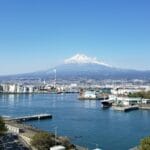
Japan makes changes to attract superyacht sector

At the recent GMBA conference in Singapore, Kenta Inaba, GMBA Japan, talked about the allure of Japan as a cruising destination. He emphasised being able to cruise in Japan all year round was an attractive aspect for superyacht owners. Japan has become an increasingly popular tourism destination, known for its unique blend of traditional culture and modern innovation. Japan offers a diverse range of attractions and experiences for superyacht owners and guests.
Inaba was enthusiastic about the significant steps the Japanese government has taken to make visiting superyachts feel welcome, stating: “The government has eased regulations on immigration, customs and quarantine for foreign-flagged vessels and provided services and dockage for superyachts of any size.
“They are also planning to upgrade ports to accommodate additional superyacht berths, reflecting their commitment to supporting the industry. Whilst currently we can accommodate visiting superyachts, like every developing industry we need to keep up with the appropriate infrastructure for the bigger yachts.”
Kenta Inaba, GMBA Japan
New rules for superyachts in Japan
Japan, with its vast coastline and abundant maritime resources, is becoming a prime destination for superyachts. Being surrounded by water, Japan’s coastlines stretch more than 35,000km and no point anywhere in Japan is more than ninety-three miles from the sea. The availability of Infrastructure (ports, airports, train stations and shipyards) is extensive throughout Japan making travel within the country easy and very accessible.
Japan is not only one of the largest producers of trading vessels globally but it also boasts a thriving maritime industry, including shipbuilding and marine engineering. Japan is one of the largest economies in the world ranking fourth after the USA, China, Germany. The population is approx. 125.9 million (2020) with income per capita as per IMF data in April 2024 being $US34,000.
The Japanese government rules have been overhauled for foreign registered superyachts. This has brought significant changes for the superyacht industry in Japan by removing some of the red tape and bureaucracy, putting Japan on a level playing field with many other superyacht destinations.
The three key changes comprise the introduction of:
(1) The ‘naikosen’ – a type of cruising permit installed.
(2) No time limit for a superyacht stay and cruise in Japan.
(3) An eligible crew pass – for as long as the yacht is in Japan and only expires when the crew member leaves Japan either by flight or on the superyacht.
These three major changes have opened the doors for growth in the Japanese superyacht sector. Superyacht owners are increasingly being drawn to Japan, as evidenced by the extended stay of one yacht that planned for three weeks but cruised sixty-six ports and stayed for over seven months. The availability of extensive infrastructure, including ports, airports, train stations, and shipyards, further enhances the appeal of Japan as a superyacht destination.
Inaba says: “The profile of the industry in Japan is changing, while small boat ownership has declined, we are seeing growth in the number of motor vessels owned in the 20-30m range.”
Japan boat charters
The charter market is an obvious opportunity to drive growth in the superyacht sector in Japan and this must certainly be on the government’s horizon. The government has already granted permission to all the main cruise lines to establish a cruising presence.
It has been shown in studies that one superyacht with 12 guests will spend more in a local community than a large cruise ship with its all-inclusive on-board packages. It has also been shown that a cruise ship provisions in main centres and from corporate wholesalers while a superyacht will provision in local communities as they cruise around the coastline. Once governments fully understand this, and the real economic value of the superyacht industry plus the many positive flow on effects to local communities, they understand the importance of reviewing their charter regulations.
There are many examples the Japanese government can look at that highlight the benefits of a thriving charter sector once regulations are changed. In New Zealand, Australia, Fiji, and Tahiti, for example, after considerable lobbying from industry, the governments opened up the opportunity for foreign-flagged vessels to charter and this has led to significantly increased private investment in infrastructure to service these vessels. The yachts have financially supported many small businesses in local coastline communities through their provisioning spend and maintenance requirements, and they have contributed substantial revenue to the economy and the sector has created significant job opportunities.
Inaba advises: “Captains and owners want a significant comfort level when cruising in new territories. It is important that visiting superyachts are confident they will receive support to be managed through the regulatory process, are able to be provisioned with their specific requirements and are provided with tailored itineraries that align with the owners’ preferences.”
Overall, there is positive news from Japan for the superyacht sector there and having a local expert like Kenta Inaba has certainly made a difference.
This article was written by MaryAnne Edwards, GMBA Australia and New Zealand
Email: kenta.inaba@gmba.blue
The post Japan makes changes to attract superyacht sector appeared first on Marine Industry News.
